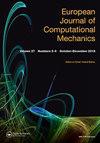Numerical and Experimental Analysis of the Anisotropy Evolution in Aluminium Alloys Processed by Asymmetric Rolling
IF 0.6
Q3 MECHANICS
引用次数: 0
Abstract
One of the most important characteristics of the sheet metal is its anisotropy. Asymmetric rolling (ASR) shows to be an adequate process to change the material anisotropy by increasing the normal anisotropy and decreasing the planar anisotropy. In this work, it is analysed the relationship between anisotropy and texture evolution using experimental and numerical approaches. Experimentally, the texture is modified by rolling, involving symmetric (SR), asymmetric rolling continuous (ARC) and asymmetric reverse (ARR) routes and different reductions per pass. The numerical analysis was performed through the visco-plastic self-consistent model where two hardening laws were considered, namely the Voce-type (V) and the dislocation density-based model (DDR). The main objective of the numerical method was to test the performance of the VPSC model for large plastic deformation. The Lankford coefficients decrease in RD and increase in TD with the increase in the total thickness reduction. This trend observed experimentally is well captured by the VPSC model, however, in terms of R-value, an overestimation is observed in both cases with better results for Voce-type law.非对称轧制铝合金各向异性演化的数值与实验分析
金属薄板最重要的特性之一是其各向异性。不对称轧制(ASR)是一种通过提高材料的法向各向异性和降低材料的平面各向异性来改变材料各向异性的方法。本文采用实验和数值方法分析了各向异性与织构演化之间的关系。实验中,采用对称(SR)、非对称连续(ARC)和非对称反向(ARR)三种轧制方式对织构进行改性,每道次进行不同的还原。通过考虑两种硬化规律的粘塑性自一致模型进行数值分析,即voice -type (V)和基于位错密度的模型(DDR)。数值方法的主要目的是测试VPSC模型在大塑性变形下的性能。Lankford系数随总厚度减小而减小,随总厚度减小而增大。VPSC模型很好地捕捉了实验中观察到的这一趋势,然而,就r值而言,在两种情况下都观察到高估,对voice -type定律的结果更好。
本文章由计算机程序翻译,如有差异,请以英文原文为准。
求助全文
约1分钟内获得全文
求助全文

 求助内容:
求助内容: 应助结果提醒方式:
应助结果提醒方式:


